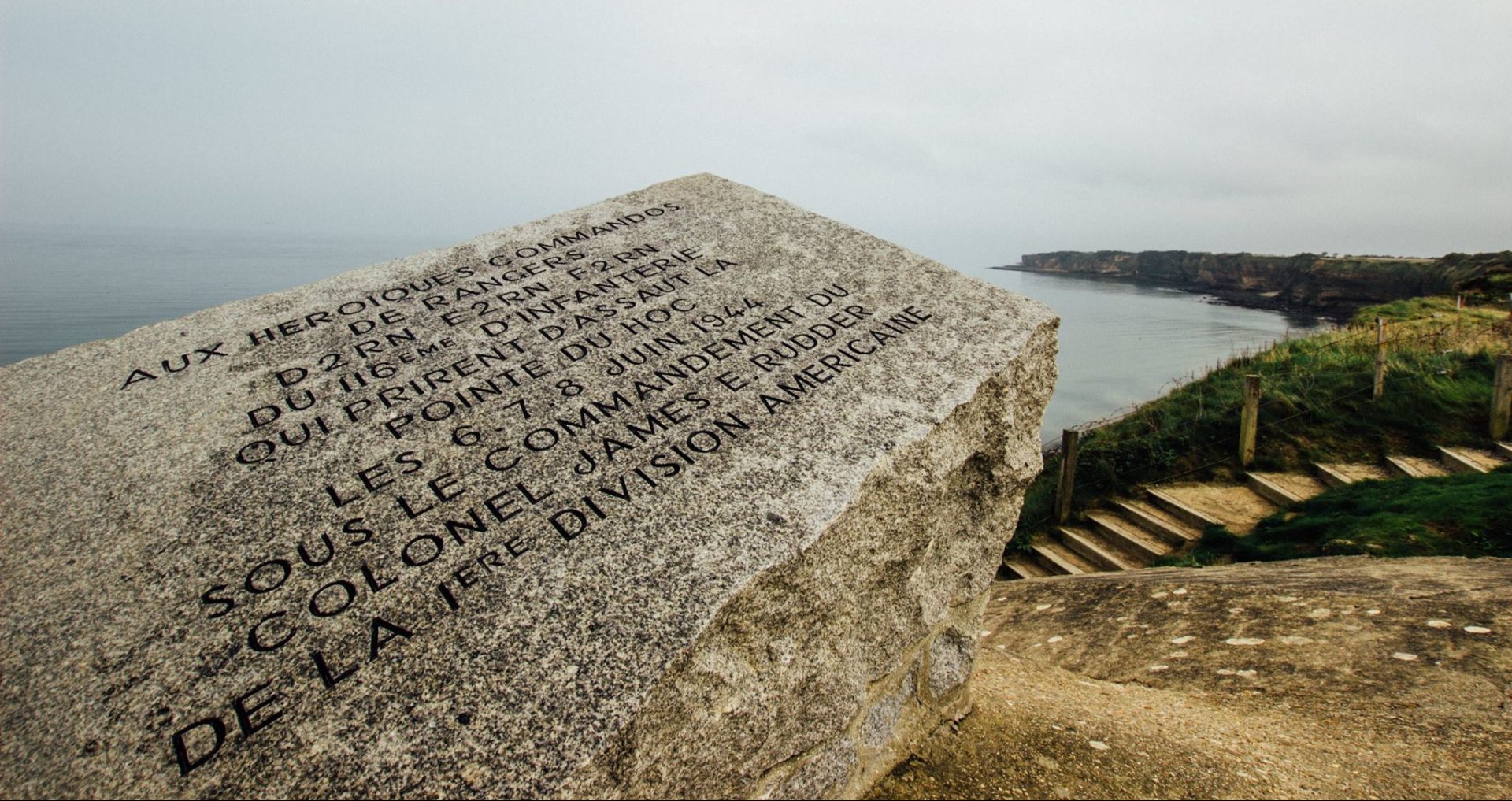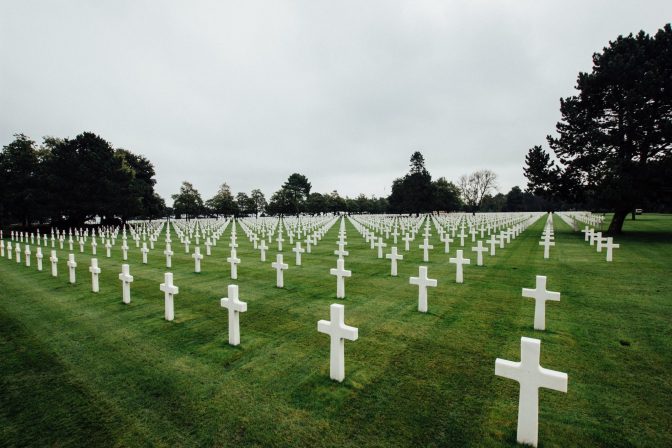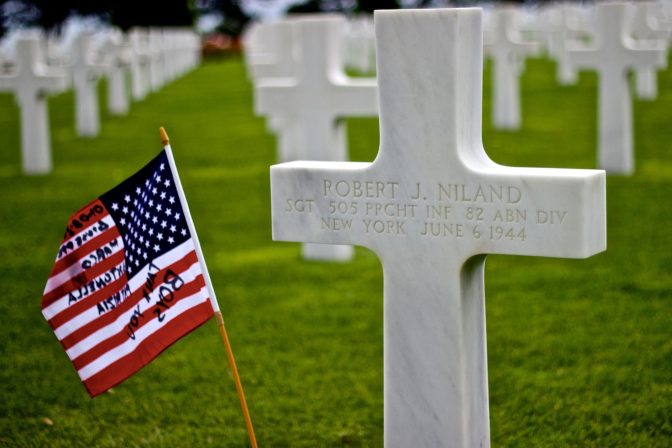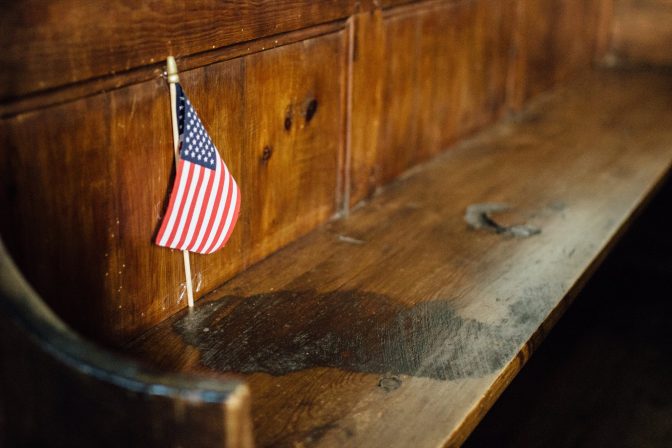
The World War II Pointe du Hoc Ranger Monument overlooking Omaha Beach in Normand, France.
Tim Lambert / WITF

The World War II Pointe du Hoc Ranger Monument overlooking Omaha Beach in Normand, France.
Tim Lambert / WITF

Tim Lambert / WITF
The World War II Pointe du Hoc Ranger Monument overlooking Omaha Beach in Normand, France.
This story was originally published on May 2, 2015.
A breeze blows through the towering green pine trees lining the walkways, while gentle waves come ashore along the beach below. It’s a little after 9 a.m., several tourists approach the gate, speaking in hushed tones. A couple of them take noticeably deep breaths before stepping inside. Nothing can prepare them for what they are about to experience.
Row after row of white Latin crosses and Stars of David are aligned perfectly, seemingly as far as the eye can see. The green grass is immaculate.
They are now standing on some of the most hallowed of grounds — the Normandy American Cemetery in Collevillesur- Mer, France.
Normandy.

Tim Lambert / WITF
The Normandy American Cemetery and Memorial is in Colleville-sur-Mer, Normandy, France.
On June 6, 1944, the United States and its allies began writing the final chapter in the struggle to end Adolf Hitler’s murderous rampage, unprecedented in its brutality and ruthlessness.
Operation Overlord was designed to open a western front to relieve pressure on Russians fighting the Germans in the east and begin the liberation of France and eventually all of Europe. The plan called for the largest seaborne invasion in history, landing troops on five beaches stretching over 50 miles. The force, consisting of mainly American, British and Canadian soldiers, would hit French soil just hours after some 24,000 paratroopers dropped behind enemy lines to create chaos and confusion among the Germans, while securing key roads and bridges.
“Soldiers, sailors and airmen of the Allied Expeditionary Force! You are about to embark upon the Great Crusade, toward which we have striven these many months. The eyes of the world are upon you,” Supreme Allied Commander Dwight Eisenhower wrote in a letter distributed to troops before the invasion. “We will accept nothing less than full victory! Good luck! And let us beseech the blessing of Almighty God upon this great and noble undertaking.”
This year marks the 70th anniversary of VE Day. May 8, 1945, is known as “Victory in Europe,” the day Germany surrendered. But, it’s easy to forget that only 11 months before, Nazi Germany still maintained an iron grip on much of the continent. The tide only began to turn through the life-and-death struggles, sacrifices, twists of fate and acts of bravery, both big and small, on D-Day. They took place in French towns such as Sainte Mere Eglise, Caen and Carentan; on beaches now only known by their code names: Omaha, Utah, Juno, Sword and Gold; and at places like Pointe du Hoc, Pegasus Bridge and La Fiere Bridge.
The 172-acre Normandy American Cemetery is the emotional center of the story of D-Day. An estimated 1 million people visit annually to pay their respects to the fallen. It overlooks the bloodiest of the five landing beaches, Omaha, and is the final resting place of 9,383 soldiers, sailors and airmen, as well as four women. On the Walls of the Missing are another 1,557 names.

Tim Lambert / WITF
A grave at the Normandy American Cemetery and Memorial is in Colleville-sur-Mer, Normandy, France.
Every grave in the 10 plots faces westward, toward the homeland of the men and women who made the ultimate sacrifice for their country. A father and son lie side by side as do 33 of the 45 pairs of brothers buried there, including Theodore Roosevelt Jr. and his brother Quentin (who was killed in World War I). There are three Medal of Honor recipients, while 307 graves are marked “Known but to God.” French President Rene Coty paid tribute to the warriors who liberated his country in a statement read at the cemetery’s opening on July 18, 1956:
“These young men who sleep their last sleep here, have earned in history their places in the first-rank of conquerors. When the survivors returned home, the dead remained together in brotherhood as they were in battle. Let us ponder the great lessons which we learn from their tombs,” he wrote. “We do not forget, we shall never forget, the infinite debt of gratitude that we have contracted with those who gave everything for our freedom.”
Pennsylvania is the most represented state with 1,213 of its men buried or listed on the Walls of the Missing. Walking along Plot E, Row 5, nine of the 40 men resting eternally are from the commonwealth, including Eugene “Pony” Vigosky, Franck Maudie and Wilbert Weaver. It’s a somber illustration of how much the liberation of France was paid for in blood, in part, by young men from the commonwealth’s steel mills, coal mines and farm fields.
Since Normandy is a region in France and not a town like, say, Gettysburg, it’s nearly impossible to visit every important site in a single day or two. Omaha Beach, Pointe du Hoc, Sainte Mere Eglise and Pegasus Bridge are among the most popular. But to truly get a feel for the enormity of the invasion and the cost of victory in blood and treasure, D-Day battlefield guides offer visitors or tour groups an opportunity to take daylong trips covering certain sectors of the fighting.
Along the way, they tell the stories of individual soldiers, like then-1st Lt. Richard D. Winters of Ephrata, whose exploits on June 5 and 6 were well-documented in several books and the HBO miniseries “Band of Brothers.” A statue in Winters’ likeness sits a few miles from Utah beach in honor of the leadership of all junior U.S. military officers who led the way on D-Day.

Tim Lambert / WITF
The Richard D. Winters Leadership monument is dedicated to the memory of all junior U.S. military officers who served on D-Day. The monument is located on the D913 between Sainte-Marie-du-Mont and Utah beach.
But the guides also make sure visitors hear about the heroism that might not have made it into the popular history books. Take, for example, the town of Sainte Mere Eglise. Walking into the center square, a lifelike mannequin of paratrooper John Steele hangs from a church steeple. Pvt. Steele’s ordeal was made famous through the book and movie “The Longest Day,” which highlights how his parachute got snagged on the church during his descent.
However, tour guides will take their group to a spot behind the building, where Sgt. Johnny Ray of the 82nd Airborne Division managed to save the lives of two of his fellow paratroopers. As he landed, he was shot by a German soldier. The enemy then turned his attention to Steele and another paratrooper who was dangling from the church, Ken Russell. Fatally wounded, Ray managed to draw his pistol and kill the German in a final, desperate act of courage.
Just outside Sainte Mere Eglise, another member of the 82nd Airborne performed a similar act of bravery. Pfc. Charles DeGlopper was posthumously awarded the Medal of Honor for his actions three days after the invasion. The outcome of the fight was still in doubt. He was part of a group of paratroopers who were ordered to seize and hold the La Fiere Bridge across the Merderet River. Historians have called the ensuing fight one of the most ferocious single unit combat actions in U.S. history.
According to his Medal of Honor citation, DeGlopper’s platoon had been cut off during an advance. During a German flanking maneuver, he walked from a ditch in full view of the enemy, firing his Browning automatic rifle. He was wounded, not once, but twice. But he continued to fire and draw attention away from his fellow troopers before he was killed. His sacrifice allowed them to withdraw to a better position.
Some nine miles away from La Fiere, a different kind of heroism was taking place in the tiny town of Angoville-au-Plain. Two medics of the 101st Airborne Division, Pvts. Kenneth Moore and Robert Wright, established an aid station in the community’s church. As detailed in preeminent Normandy battlefield guide Paul Woodadge’s book, “Angels of Mercy,” the two Screaming Eagles treated soldiers from both sides on the condition their weapons were left outside the doors.

Tim Lambert / WITF
A blood-stained pew in the church at Angoville-au-Plain
Even as the town changed hands several times, the two medics did not stop their work. To this day, bloodstains remain on several of the pews as a reminder of the brutality of the fighting and the kindness of Moore and Wright. Among the church’s stained-glass windows are two honoring the two medics as well as U.S. paratroopers.
The ultimate cost of the Battle of Normandy, from June 6 to late August 1944, is estimated at 209,000 Allied casualties, including 54,000 killed. Some 200,000 German soldiers were killed or wounded. Another 15,000 to 20,000 French civilians were also killed.
Since D-Day, many of the small villages across the Norman countryside have maintained their same rural characteristics. The big, thick hedgerows are gone, but the unique Normande cattle still roam the farm fields and pastures.
What also hasn’t changed is how grateful the people are toward their liberators, many of whom are in their 90s now. Returning veterans are given a hero’s welcome. American flags are a common site, far from the popular battlefield destinations. Some hang in the windows of many homes, while others are the small handheld sort tied to fence posts or planted near driveways. Several towns have raised enough money to build and maintain monuments or markers to honor specific units or individual soldiers.
They pass the stories of how their Allied liberators came from the skies or fought from the beaches from generation to generation, never forgetting or failing to appreciate the true cost of the road to liberty.
The days of journalism’s one-way street of simply producing stories for the public have long been over. Now, it’s time to find better ways to interact with you and ensure we meet your high standards of what a credible media organization should be.